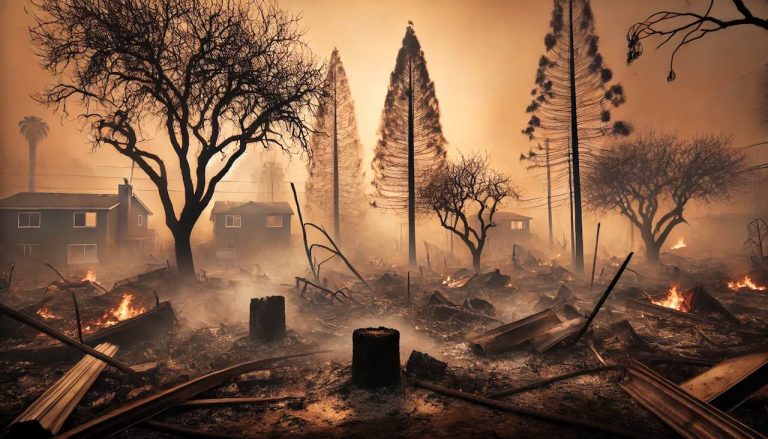
this washington post (The Washington Post) recently published an article claiming that President-elect Donald Trump’s choice for Energy Secretary Chris Wright was wrong for claiming that climate change is not fueling more frequent and severe wildfires. [emphasis, links added]
Wright was right, Wapo was wrong.
Climate change is not causing more severe wildfires, but policies pushed by California Democrats and at the state and federal levels may be contributing factors.
The article “Trump’s pick for energy secretary refuses to link climate change to wildfires” complains that Chris Wright “believes Climate change is not causing more frequent and severe wildfires — a claim that is inconsistent with scientific consensus.“
Asked by Sen. Alex Padilla, D-Calif., during his confirmation hearing if he thought wildfires were “just hype” when it comes to climate change, Wright responded He stood by his past statements and rejected claims that climate change is causing more and more severe wildfires.
washington post (WaPo) cites a study that only looked at the past 20 years. Other fire records go back further and are more comprehensive.
The Washington Post also quoted climate warning scientists Michael Mann and Andrew Dessler, both of whom have a somewhat untrustworthy past when it comes to confirmation bias on climate change.especially when it comes to how to analyze data, by climate realism Here and here respectively.
Look at the recent California wildfires, which these alarmists blame on climate change. This statement is inconsistent with the evidence.
For example, as atmospheric scientist Cliff Mass points out, even if the region doesn't experience a dry winter, Weather conditions are such that even if it rains the day before a fire, a fire can still occur.
This is because the dry Santa Ana winds are strong enough, Eventually burned grass and vegetation will dry out regardless of pre-existing wet conditions.
California's winter rainy season does start later, but that's not part of a long-term climate trend. Los Angeles winter rainy season trends are Precipitation has increased since the 1950srather than reducing. (see picture below)

In fact, wet conditions in previous years promote the growth of dense shrubbery, and when a dry year arrives, Dries out, providing fuel for fires.
So it's clear that this year's fires It’s not a climate issue, it’s a weather phenomenon. Washington Post claims Wright clashes with climate science, but climate science backs it up The Santa Ana winds that dry out fuels and intensify wildfires should decrease as the climate warms.
As Maas explains:
It makes perfect sense that global warming would weaken Santa Ana winds.
This wind is driven by the pressure difference between high pressure inland and low pressure to the south and west. This high pressure is associated with low-level cold air (cold air is denser and heavier than warm air), which is warmed by global warming and thus reduces the pressure difference that drives the Santa Ana winds.
Globally, the amount of land burned by wildfires has decreased significantly, as has the amount of land burned by wildfires in the United States since the early 20th century.
The area caused by wildfires has increased slightly in recent decades, and WaPo is happy to ignore why: Conservationist-driven land management practices and demographic changes More people are moving into areas historically prone to wildfires.
Meteorologist Anthony Watts explained in the post “No, mainstream media, California wildfires are not to blame on climate change”:
Decades of fire suppression policies have allowed fuels (also known as dead trees, dry brush and dense vegetation) to accumulate, creating flammable conditions. A report from Cal Fire explains the role of vegetation management in reducing fire risk and outlines how fuel accumulation can make fires more severe.
At the same time, urban expansion into wildland areas (the so-called wildland-urban interface) puts more homes and infrastructure at risk. Research from the University of California, Berkeley, highlights the challenges posed by housing development in fire-prone areas.
Historically, fires that would have caused the natural thinning of forests and clearing of underbrush were suppressed, resulting in denser forests and more intense burning.
That's true for California, and it's true for many other parts of the country, especially in forests managed by the federal government (or rather, mismanaged) rather than by private property.
It was not until the late 1980s and early 1990s that fires in the United States began to show a slight upward trend, coinciding with policy shifts in federal forest management philosophy that resulted in Timber harvest on federal lands plummets.
At the same time, forest roads used by loggers but also to fight fires were removed or closed. This results in fuel accumulation, making it impossible to extinguish fires in remote areas before they reach population centers.
WaPo also does not seem to understand what the Intergovernmental Panel on Climate Change (IPCC) actually said in its Sixth Assessment Report, i.e. Even under the extreme warming model scenario, “fire weather” has not gotten worse and is not expected to get worse between 2050 and 2100. (see picture below)

In this case, Wright proved he knew more about the “consensus” science on wildfires than the Washington Post writer did.
A thoughtful man, Wright correctly acknowledged in his testimony the tragic and horrific devastation caused by the California fires and expressed sympathy for those suffering there.
But he is equally right to refuse to attribute it to climate change, as Democrats and the alarmist media urge him to do.
The Washington Post should consider fact-checking before citing scientists known to have crossed over to advocate for “consensus science” on wildfires. The Washington Post certainly leaves readers feeling “in the dark” about climate reality.
Read more Climate Realism
